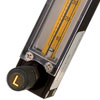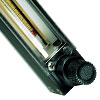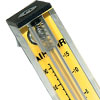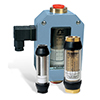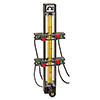Variable area flow meters are simple and versatile devices that operate at a relatively constant pressure drop and
measure the flow of liquids, gases, and steam. The position of their float, piston or vane is changed as the increasing flow rate opens a larger flow area to pass the flowing fluid. The position of the float, piston or vane provides a direct visual indication of flow rate. Design variations include the rotameter (a float in a tapered tube),
orifice/rotameter combination (bypass rotameter), open-channel variable gate, tapered plug, and vane or piston designs.
Either the force of gravity or a spring is used to return the flow element to its resting position when the flow lessens. Gravity-operated meters (rotameters) must be installed in a vertical position, whereas spring operated ones can be mounted in any position. All variable area flow meters are available with local indicators. Most can also be provided with position sensors and transmitters (pneumatic, electronic, digital, or fiberoptic) for connecting to remote displays or controls.
Purge Flow Regulators

If a needle valve is placed at the inlet or outlet of a rotameter, and a d/p regulator controls the pressure difference across this combination, the result is a purge-flow regulator. Such instrumentation packages are used as self-contained purge flow meters. These are among the least expensive and most widely used flow meters. Their main application is to control small gas or liquid purge streams. They are used to protect instruments from contacting hot and corrosive fluids, to protect pressure taps from plugging, to protect the cleanliness of optical devices, and to protect electrical devices from igniting upon contact with combustibles.
Purge meters are quite useful in adding nitrogen gas to the vapor spaces of tanks and other equipment. Purging with nitrogen gas reduces the possibility of developing a flammable mixture because it displaces flammable gases. The purge-flow regulator is reliable, intrinsically safe, and inexpensive.
As shown in the figure, purge meters can operate in the constant flow mode, where P
2 - P
0 is held constant at about 60 to 80 in H
2O differential. In bubbler and purge applications, the inlet pressure (P
1) is held constant and the outlet pressure (P
0) is variable.The figure describes a configuration where the outlet pressure (P
0) is held constant and the inlet pressure (P
1) is variable.
They can handle extremely small flow rates from 0.01 cc/min for liquids and from 0.5 cc/min for gases. The most common size is a glass tube rotameter with -in (6 mm) connections, a range of 0.05-0.5 gpm (0.2-2.0 lpm) on water or 0.2-2.0 scfm (0.3-3.0 cmph) in air service. Typical accuracy is ±5% FS over a 10:1 range, and the most common pressure rating is 150 psig (1 MPa).
Rotameters
The rotameter is the most widely used variable area flowmeter because of its low cost, simplicity, low pressure drop, relatively wide rangeability, and linear output.
Please, read this article where the
working principle and types of rotameters are explained.
Other Variable Area Flow meters
Major disadvantages of the rotameter are its relatively high cost in larger sizes and the requirement that it be installed vertically (there may not be enough head room). The cost of a large rotameter installation can be reduced by using an orifice bypass or a pitot tube in combination with a smaller rotameter. The same-size bypass rotameter can be used to measure a variety of flows, with the only difference between applications being the orifice plate and the differential it produces.
Advantages of a bypass rotameter include low cost; its major disadvantage is inaccuracy and sensitivity to material build-up. Bypass rotameters are often provided with isolation valves so that they can be removed for maintenance without shutting down the process line.
Tapered plug flow meters are variable area flow meters with a stationary core and a piston that moves as the flow varies. In one design, the piston movement mechanically moves a pointer, while in another it magnetically moves an external flow rate indicator. The second design has a metallic meter body for applications up to 1,000 psig.
One gate-type variable area flow-meter resembles a butterfly valve. Flow through the meter forces a spring-loaded vane to rotate, and a mechanical connection provides local flow rate indication. The inaccuracy of such meters is 2-5% FS. The meter can be used on oil, water and air, and is available in sizes up to 4 inches. It also is used as an indicating flow switch in safety interlock systems.
 CLOSE
CLOSE

 If a needle valve is placed at the inlet or outlet of a rotameter, and a d/p regulator controls the pressure difference across this combination, the result is a purge-flow regulator. Such instrumentation packages are used as self-contained purge flow meters. These are among the least expensive and most widely used flow meters. Their main application is to control small gas or liquid purge streams. They are used to protect instruments from contacting hot and corrosive fluids, to protect pressure taps from plugging, to protect the cleanliness of optical devices, and to protect electrical devices from igniting upon contact with combustibles.
If a needle valve is placed at the inlet or outlet of a rotameter, and a d/p regulator controls the pressure difference across this combination, the result is a purge-flow regulator. Such instrumentation packages are used as self-contained purge flow meters. These are among the least expensive and most widely used flow meters. Their main application is to control small gas or liquid purge streams. They are used to protect instruments from contacting hot and corrosive fluids, to protect pressure taps from plugging, to protect the cleanliness of optical devices, and to protect electrical devices from igniting upon contact with combustibles.